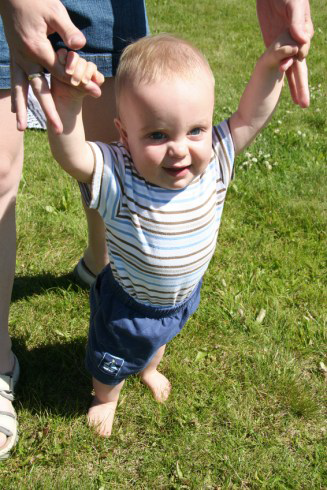“Disability” and Development: Do We Have the Right Focus?
I began training in this field over 40 years ago. Reflecting back now I am embarrassed to realize how long it has taken me, and most of my colleagues, to recognize that the fundamental challenges faced by children with the range of conditions we see in our clinics and services involve and concern development – how to ‘become’ a distinct and ‘functional’ individual in the face of their ‘condition’ and its apparent limitations1 . What I have come to believe is that our fundamental concern in developmental pediatrics and in “developmental disability” should be to encourage, promote, enhance and otherwise foster the development of children (and their families) to the best of their capacity, in their own ways, ‘despite’ the presence of impairment. I believe that this emphasis should trump our longheld beliefs that development needs to happen ‘normally’ and that the neurodisabilities have to be ‘treated’ and ‘cured’.

The reality is, of course, that from birth onwards (starting, in fact, in utero) children grow, change and constantly develop throughout their ‘formative’ years. This process of change in size and capacity – this process of ‘becoming’ – is certainly the defining element of what distinguishes children and youth from adults.
“Development pediatrics” is a relatively new branch of child health. It engages the skills and interests of professionals specifically to address the challenges faced by infants, children and young people, and their families, with health conditions that do, or are likely to, influence children’s development. These conditions are collectively referred to as “neurodisabilities”, a term more popular in the UK than in North America. The word reminds us that many of the young people in whom we are interested have a neurological impairment as part of their condition. Insofar as the brain is the primary organ of development, the concept of “neurodisability” seems self-evident.
We have argued elsewhere2 that our professional emphasis on ‘treatment’ is somewhat naïve and incomplete. With our field’s traditionally strong focus on “treatment”, we have forgotten to ask ourselves what the child with a neurodisability will be doing if/when they have completed their ‘treatment’! What do we hope the treatments will empower children to do? In other words, what are the developmental activities that form the foundations of a child’s understanding of their world – and how might these be achieved? Must things follow a defined and ‘normal’ path, or can we be more liberal in our expectations of child development?
Consider this example of a variant of typical development. Two years ago I became the proud grandfather of Nova, a delightful, engaging, healthy, well-developing girl whose progress we have followed avidly. Just for fun (and without grandparental prodding!) my daughter started to teach Nova sign language as an infant. The baby was using signs by six months, and was an excellent communicator with her parents – using signs as her words. Probably for reasons of temperament (she is a cautious child and an observer of her environment), Nova was thought to be a bit ‘slow’ to meet talking (oral speech) milestones – an observation made at 18 months at a well-baby check-up. However, by 23 months she was talking non-stop in sentences, demonstrating remarkable conceptual capacity, and was no longer using (or perhaps even remembering) her signs! Was this abnormal or simply a variation in development?3
Perhaps one explanation for our failure to identify the obvious importance of child development is that our training as health professionals, in almost all our disciplines, has so strongly focused on the biomedical dimensions of the problems, and on labeling the condition as a basis for ‘treatment’. Our traditions have encouraged us to make the correct diagnosis, and then offer the best biomedical interventions, with the assumption that when the conditions are improved by our treatments, function will follow. Evidence suggests that this is not necessarily the case.4
We have also assumed that we can apply the lessons and experiences of adult ‘rehabilitation’ to our work with children – and indeed there is much to learn from our ‘adult’ colleagues. What is not so apparent, however, is that rehabilitation is designed to help an impaired adult return, as closely as possible, to a former state of functional capacity – whereas the comparable challenge for children is to develop skills and abilities that they have never (yet) possessed!

We have also not recognized as well as we ought to the difference between what must be the distinct processes involved in the immature central nervous system developing a basic capacity (such as mobility or communication), and those involved in improving or repairing one’s skills in those aspects of function once it has emerged.5 A powerful example of how the brain is wired to accommodate and develop inputs from the outside world is the recognition of the ‘sensitive periods’ for vision to develop normally.6 It appears that ‘development’ requires, in addition to neurological integration, genetic predisposition and opportunities to work at the emergence of the function. Rehabilitation involves working with people who have acquired a functional problem, in order to help them recover their established but impaired capacities. It almost certainly requires and uses very different brain mechanisms than those that are involved in the development of these capacities in the first place. These ‘developmental’ factors clearly include having a healthy neurological system with its readiness to learn, but also involve training, motivation, interest, opportunity….
I believe that those of us who work in the field of “applied child development” (developmental disability) need to re-focus our attention on child development as the primary guiding principle by which we offer advice, intervention, and counseling to parents. We need to recognize that it is essential to blend the best of our biomedical interventions with a strong and continuing emphasis on promoting children’s development. Our goals should be to encourage parents to help their children become as independent, capable, self-confident and able as they can be – and not expect that everything has to be learned and done ‘normally’.7
It is essential to recognize that in the face of functional limitations many children with impairments can be “deprived” of the ordinary experiences of childhood such as exploring, taking risks, getting into what adults call “mischief”, and generally leading the dance that characterizes the relationship between children and their parents. Thus, when children are unable to move around their environment to explore, or to talk (and talk back!) their parents cannot experience the ordinary adventures of child development, or know how to respond to the functionally challenged child as they will be able to do when the child is following a more typical path.
It thus becomes very important, as professionals, to ask ourselves: ‘What are the implications of this child’s impairment on their function in everyday life?’ and then to counsel parents about these realities. We need to support parents to allow their children to interact with the human and physical environment to the greatest extent possible, and trade off “normal” function (our traditional standard) in favour of developmental exploration, life experience, and opportunities to learn how they and the world around them work – even if those children do things ‘differently’ because of impairments that preclude ‘ordinary’ development. (We also need to acknowledge that there is tremendous variation in what we call ‘typical’ or ‘normal’ development, and allow the children we see the latitude to do things their own way!3)
To some people this set of ideas suggests “giving up” on treatment. Nothing is further from the truth!
In fact the ideas being proposed in this essay concern how we are thinking about the advice we offer to parents, rather than whether treatment should be offered at all. It is important to be aware that there are times when our treatment beliefs may lead us to inhibit children from becoming as active as they would. One example would be the school of thought (among some schools of therapy) that feels that the use of mobility aids such as walkers should not be provided. The worry is that if walkers make it “too easy” for children to get around the children will become “dependent” on them.
When I hear that idea I challenge both parents and therapists as to whether other children in their family have been ‘allowed’ to use training wheels when learning to ride a two-bicycle! That often helps people to recognize the inconsistency in their thinking, and to at least consider ‘augmentative’ equipment for children with impairments to enhance function and hence life experience. Similar concerns are often raised about the use of augmentative and alternative communication (AAC) interventions. Once again, there is to our knowledge no evidence that the use of these alternative communication methods inhibits children’s language development – and plenty of anecdotal evidence that it promotes ‘function’.
In fact, AAC approaches often provide the scaffold on which children can begin to develop communicative capacity, can elicit responses from their parents, and can tell us “what’s on their mind”. All of these interventions are designed to promote child development, capability and the capacity to become whoever one might be. They also illustrate powerfully what we mean by a ‘transactional’ approach to child development,8 in which enhanced functional capabilities allow children to demonstrate what they know/want/think/can do – in turn allowing parents to interact with their ‘more capable’ child, thus perpetuating the ‘virtuous circle’ of childparent-child-parent…interaction.

It is my belief, subject to more studies, that parents appreciate a perspective on what their children can do, rather than a continuing emphasis on the child’s difficulties.9 It is self-evident that children come into our orbit because of difficulties in their development, and parents rarely need to be reminded about their children’s limitations! On the other hand when we ask parents what they want to brag about, or invite them to describe their children’s strengths, many find it difficult to do. Some have indicated that they are so accustomed to thinking about their children’s problems that the emphasis is always on the difficulties and rarely if ever on what is going well in that child’s life.
In summary, we are arguing for an emphasis from professionals on child development, promoting capabilities and strengths, and encouraging families to provide an environment in which parents have a positive view of their children’s emerging capacities even when those capacities are different or perhaps compromised in some way. The emphasis on child development “normalizes” what children are all about, while in no way ignoring the challenges they may face by virtue of restrictions in one or more areas of their function, or their need to receive the best of what our evidence-based interventions have to offer.
It is hoped that these ideas will provide a basis for discussion between parents and professionals, and provide a stimulus for further research into a strengths-based and developmental focus on “developmental disability”.
